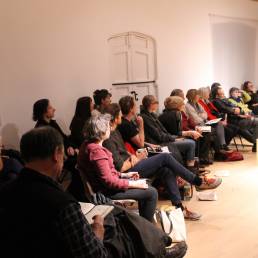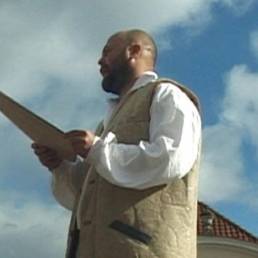Ropewalkers brings together new work by artists Jo Ball, Andy Parker and Simon Whetham made in response to the architecture, history and materials of Dawe’s Twineworks Museum and social history project.
A monument to working class history Dawe’s is thought to be the only rural twineworks remaining in England with all its machinery, the last example of what was the most important industry in South Somerset for over 500 years.
By placing art at the heart of the museum visitors are encouraged to see the past with new eyes, revealing narratives that are hidden in the machinery, archives and soil surrounding the Twineworks.
The exhibition takes place across two venues, OSR Project Space and Dawe’s Twineworks and includes an immersive sound work by Simon Whetham entitled Trace Evidence, performance and sculpture by Andy Parker, A New Voyage, that weaves together personal histories with that of William Dampier and the Twineworks, and Jo Ball’s project Patches of Blue Sky re-visits the tradition of growing flax to make linen twine.
Exhibition: 15 October – 5 November 2016
OSR Project Space, Church Street, West Coker, Somerset UK
Dawe’s Twineworks, 94a High Street, West Coker, Somerset UK
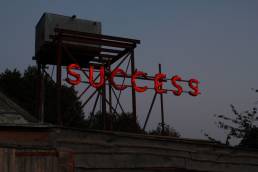
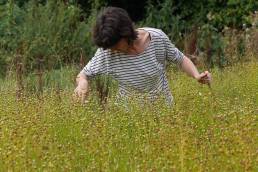
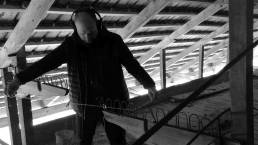

Simon Whetham – Trace Evidence
The production or twine ceased at Dawe’s Twineworks in 1968, however, much of the equipment and materials that used twine production through that period still stand
at the site, silent witnesses retaining memories of the activities involved.
At the works:
It is easy to trace the path of twine along the site and through the stages of production, as the constant contact of refined flax on materials such as wood, glass and steel have left their mark. Friction has worn furrows and grooves in these solid materials, which to this day clearly bear the scars.
When exploring the site it was clear that the open structure already allowed the everyday sound of nature and human activity to enter and pass through. However, what of the sounds of the past, held dormant in the fabric of the building? To reanimate these sounds of twine production twine was run along the grooves and marks left behind and these actions were recorded using contact microphones, capturing only the sound of vibration through the object.
Each witness mark left on a nail, a glass rod, a wooden rake, a cast iron idler, all sang with their own voice, differing in timbre and tone from the others. These individual voices were gathered and subsequently combined through composition to create a sense of movement along the site.
The journey begins with further sounds that can be heard on occasion, such as the engine running, the drive belt changing, the chimney puffing, but also those of the internal vibrations of materials, unheard, such as the drive belts in their guides, spindles spinning, long wires rocking. Then along the ropewalk you follow the journey of the twine as it runs through rakes and guides, over drums and idlers.
To hear the sounds, you require a set of headphones, and with these you plug into various points on the site, hearing echoes of activities that have passed, the sound travelling through the entire structure of the building.
At OSR Projects space:
An observation during the exploration of sounds at the Twine Works was that often the sounds of belts rubbing on guides and twine running along grooves were reminiscent of the sound the stylus makes when placed into the groove of an old record.
The idea then developed, as the sounds of grooves in materials at the site being played back from grooves cut into a vinyl disc held a pleasant harmony. The sounds have been transferred to vinyl disc using a method of cutting, rather than the more resilient method of pressing, which means that each time the disc is played, the tracks within will deteriorate. With repeated playing, over time the sounds will in effect disappear, once more lost to the past.
The sounds are presented in the gallery through speakers to fill the space, internal sounds being externalised, as a contradiction to the way the work has been presented at Dawe’s Twine Works.
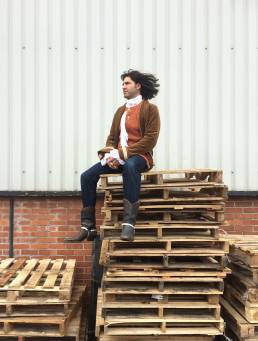
Andy Parker – A New Voyage
In 1701 William Dampier, Naval hydrographer, explorer and pirate, who grew up near West Coker, watched from the shore of a deserted island as his worm-eaten ship, the Roebuck, sank to its gunnels in a shallow bay.
With tents made from the Roebuck’s sails the crew were marooned for 5 weeks until rescue came, but aside from that this ‘desolate Island Ascension’ remained uninhabited for hundreds of years. Occasionally ships would put sick sailors ashore where they would be left to die of yellow fever or some other contagion. They would endure their final days in isolation – each one burying the remains of their predecessor. It is rumoured that Dampier buried treasure there too.
I’d not heard of William Dampier or his treasure when my Mum visited Ascension Island. I was interested in the yellow fever graveyardI’d not heard of William Dampier or his treasure when my Mum visited Ascension Island. I was interested in the yellow fever graveyard, and Mum agreed to find it for me. Her friend Stedson Stroud, one of the few residents of the island, drew her a map on a piece of paper. It seemed straightforward enough but the distances were deceptive, and with no water or shelter from the sun Mum returned to the town hours later much the worse for wear. She didn’t find the graveyard and brought me home only the crumpled piece of A4 paper to show for her adventure.
“Success to the Roebuck!” – the word “success” was used on ships’ launching boards as a wish bestowed upon the vessel on its maiden voyage. The sense of hope is as clear as the sense of judgement in things whose success is measured after the event. Dimly glowing above the roof of Dawes Twineworks a sign declares ‘success’, writ large above the salvaged hulk of obsolete industry in a form somewhere between a kitsch 1970’s fireplace and a motel sign from California (or the West Coker Motel). Suburban aspiration and luxurious comfort are a world away from the glowing log dragged from the fire of a pirate’s desolate beach shelter, or the dying fire from the belly of an industrial boiler. Perhaps this is the fading judgement of past glories, or perhaps it is success as a wish for the future. ‘Success to the Twineworks!’
Aside from the lost wreck of an old ship, Dampier’s greatest legacy were his journals recording observations from around the world and published for a wider audience. They told a story of distant people and places, allowing readers to imagine a new world and new possibilities. He didn’t write about what kind of shoes he wore, or what music he liked. His portrait hangs in the National Gallery but it’s just his head and shoulders, and all we can see is what the artist and sitter have sanctioned to show us. I thought he’d like to wear cowboy boots. In 2016, dressed a bit like William Dampier, Naval hydrographer, explorer and pirate, I walked around West Coker, directed by a hand drawn map. As I walked I recorded observations from around the village. I made illustrations of the things I found of interest, the things he found of interest, piecing together an idea of life from what we saw.
The Roebuck was found in 2001. It wasn’t where the researchers thought it would be. Stedson Stroud inadvertently found it near the yellow fever graveyard.
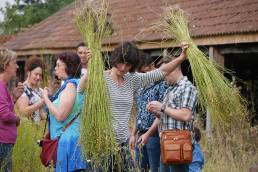
Jo Ball – Patches of Blue Sky
Working as a gardener for the last four years has given me a greater awareness of place, and how longer-term involvement in one location can change your perceptions and understanding of a particular site.
I saw the Ropewalkers commission as a way to combine art-making and gardening, and explore a new way of making art that invited people to take part. I wanted to connect people to the soil, to sow seed and have the experience of watching and caring for a plant as it grows.
A call to participate was sent out in February 2016 and over the summer eighty people in the village, and further afield, grew flax. Pictures of the sky blue flowers were sent in from across South West of England and from as far away as Norway, Toronto and the isle of Skye (many of which can be seen on the blog). Harvest events were held at the Twineworks in late summer where people brought in the bundles of flax they had been growing in their gardens and allotments.
Initially making the twine was my main aim, and this will still happen, but during the residency the social dimension has become the most valuable part of the project. For me it is the connections made during this process that is important, with support from people in the village, emails from growers further afield with updates on their progress and the two harvest events which were days full of conversations and remembrances, as the markers of success.
Alongside growing flax, I have been investigating the history of the twine industry and agriculture of West Coker and the surrounding areas. This has led to new drawings and sculptural work that refer to land, mapping and language.
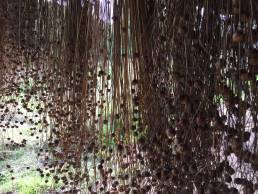
Review by Richard Povall
On this late October day, sitting outside in what we might, I suppose, now call the ‘garden’, I’m less disorientated than on my previous visit to the Twineworks and the village of West Coker in Somerset.
‘Ropewalkers’ brings together new work by Jo Ball, Andy Parker and Simon Whetham on two sites: at Dawe’s Twineworks Museum and just a little further into the village, at the OSR Project Space. I go against my usual practice and make the mistake of reading the artists’ statements before exploring the work –– a mistake only in the sense that I never wish to be predisposed in any way before I experience an artwork, for better for worse. I’m oddly privileged sitting here, all alone. This is after all a public place, and yet I have carte blanche to spend as much time here as I like, unhindered by others’ muttered conversations or distracted by any running commentaries. Unhindered, too, by seeing how others respond to the work.
Being here alone only serves to make me more aware of the ghosts in this place. During its lifetime as a working factory was it ever as loved and cherished as it is now? I feel the extraordinary passion of the volunteers who keep this rather forlorn site alive, in the very fabric around me. It can be hard for art to compete in circumstances like these. This relic is thought to be the last rural twineworks remaining in England with all its machinery, a last vestige of what was the most important industry in this part of Somerset for more than 500 years.
I’m glad I’ve started here rather than in the formality of the gallery space. Simon Whetham’s piece is spread across the site, hidden but not, easy to find if you look, but easy to overlook if you don’t. In this sense, it is the most embedded of these three pieces, literally part of the fabric. I pick up a pair of headphones from the rack and find the first portal, I plug in the headphones and am immediately lost in a soundworld the belongs entirely to this place, extends it, tells its stories, abstracts it yet somehow makes it more concrete. As I wander along the length of the very long building (designed for unbroken lengths of twine-in-the-making) I see a little speaker and a galvanised washer hanging on a piece of sisal clearly encouraging me to play. A contact microphone picks up the sound of metal against metal and gently amplifies it as I play with the nails that once held and separated lengths of twine, playing a tune with the washer. There is an almost unbearable charm about this that feels utterly compelling. I find one or two more of these and, on this late October day, I could sit here for hours revelling in this simple new instrument.
I realise I am surrounded by Jo Ball’s work, which is the most subtle presence within the exhibition. Beautiful hand-baled sheafs of flax hang drying here. A gardener, Jo’s original intention was to grow flax with a view to revisiting the making of traditional linen, but instead created a far-reaching community growing project. She became obsessed with the growing of the flax itself, inviting people across the world to grow flax from seed as a remembrance for a plant that has almost become lost and mourning the loss of a once- pervasive cottage industry. I’m moved by this – primarily because of its understatement, its gentle presence within the space – just clumps of hand- pulled flax hanging upside down to dry.
Speaking earlier with Simon Lee Dicker, the artist behind OSR Projects and the curator of this exhibition, I learnt of his enthusiasm for Andy Parker’s work and his high expectations for this project. But for me it feels too forced, too complex in its narrative, too artfully expressed, too abstracted. This is odd, because Andy has clearly been drawn to the history of this place and has drawn on the story of one particular character and woven a new narrative in attempting to draw contemporary presences. Here at the Twineworks the presence is minimal, a lit outlining of the word ‘success’ mounted on the roof of the building. It’s daylight of course, so the word sits there inertly, looking puzzling rather than successful. I’m hoping that the second part of the work, in the more formal surroundings of the exhibition space down the road will enlighten me.
On the way there I walk through the churchyard and am rather enchanted by the presence of some of Jo’s flax in the porch of the church where Harvest Festival has recently been celebrated. This above all evidences Jo’s reach into the community with this project.
Entering the OSR space itself is always a special moment. This former school remains unaltered on the outside, and it’s always a surprise to walk through the oak door into a clean, white gallery space. Most dominant within the space – immediately so – is Simon’s soundscore, playing on vinyl in the middle of the space. Here the work feels much more like the composed soundscore that it is, but loses something in its removal from the context of the Twineworks.
Another collection of drying flax lies in one corner of the room: I’m drawn to kneel and look at the twine binding the sheaf together and see a hand- stamped metal token proclaiming it to be ‘Coker Flax’, and on the other side, belonging to ‘Jo Ball’. I realise with a momentary sadness that I’ve seen nowhere within the exhibition the contribution of all those who became involved in the project – in this iteration of the piece, the community is missing, which seems a shame. On the wall is a series of what appear to be reproductions from ‘The Annals of West Coker’ recording crop rotations, names of field, and more – an agricultural record. It’s only after a while that I realise this is no mere photocopy but a meticulously hand-drawn artefact that may or may not be entirely fictitious. It’s luscious.
Andy Parker’s work is its own fiction and is by far the most visually dominant within the space. Andy is attempting a contemporary re-telling of the story of William Dampler, Naval hydrographer, explorer and pirate – the very model of a Jacobean privateer. It’s a re-telling that displays near-contemporary found objects as if they were a treasure horde, and photographs of the artist dressed as Dempster roaming the local shops, as if marooned here awaiting the repair of his ship. But I find it forced and uncomfortable. It leaves me untouched, a re-telling of a story I’m not sure I quite understand –– or want to.
Richard Povall www.artdotearth.org
